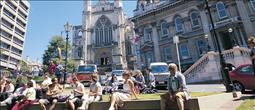The University of Otago will observe the 150th Anniversary of the Otago Gold Rush on May 21 with a Family History Seminar by the Dunedin Family History Group.
Students, academics and the administrative staff of the University of Otago will also mark the sesquicentennial with a number of events in the Campus.
The Otago Gold Rush started 150 years ago when Gabriel Read of Australia found gold, not before a long and arduous journey and facing the cold shoulder of the people of the region.
Read was a gold prospector experienced in the goldfields of California and Victoria in Australia. He travelled to New Zealand, hoping to find gold in Mataura, Southland.
Having heard of a find by one, ‘Black Peter,’ at a locality known as Woolshed Creek, Read set off for that area, and despite a good deal of good-natured derision from the local inhabitants, he disappeared into the hills and gullies, and on May 23, 1861 struck colour in a gully that has borne his name for a hundred years.
Indian help
In a speech at the 85th Annual Meeting of the New Zealand Indian Central Association in Palmerston North on April 16 (Indian Newslink, May 1, 2011), Governor General Sir Anand Satyanand recounted a fascinating story of the concerns of New Zealand’s first non-Maori settlers regarding the discovery of gold.
“While Australian Gabriel Read is credited with having discovered gold at Tuapeka in Otago, it was an Indian man, Edward Peter, who told him where it could be found,” he said.
Two years ago, Sir Anand unveiled a memorial at Glenore near Milton in Otago.
The gold was easily accessible, not more than a few feet down beneath a soft overburden of slatey shale.
Magnanimity personified
Having satisfied himself that he had stumbled across a rich deposit, and that the gold could easily be worked, Read gave a demonstration of that unselfishness and consideration which set him apart from the majority of those who benefited by his find. He had already written a letter to the Otago Witness declaring that the “Waitahuna and Tuapeka goldfields will before long astound the province.”
He went one better and announced his discovery, giving the location and prospects, holding back nothing.
Though Gold Was found in Gabriel Gully, it was discovered in other parts of the Otago region and Southland from 1861 until the end of that century.

The Gold Rush and founding of the Gold was considered another achievement of the Scots from Scotland of the United Kingdom who eventually converted Otago and Southland into ‘Southern Scotland.’
Most of the miners of the Otago Gold mines were Scots who settled in the Southlands and Otago. American Scholar Arthur Herman has mentioned this in his book How the Scots Invented the Modern World: The True Story of How Western Europe’s Poorest Nation Created Our World & Everything in it.
The Otago Gold Rush set the tone for further immigrants in New Zealand from Scotland, Ireland and Britain in the late 19th and early 20th century.
The Gold Rush enabled the establishment of the Otago University, the first in New Zealand. It was generously funded by the Gold Miners in 1869.
The city of Dunedin (founded in 1848), reaped benefits by becoming New Zealand’s largest town.






